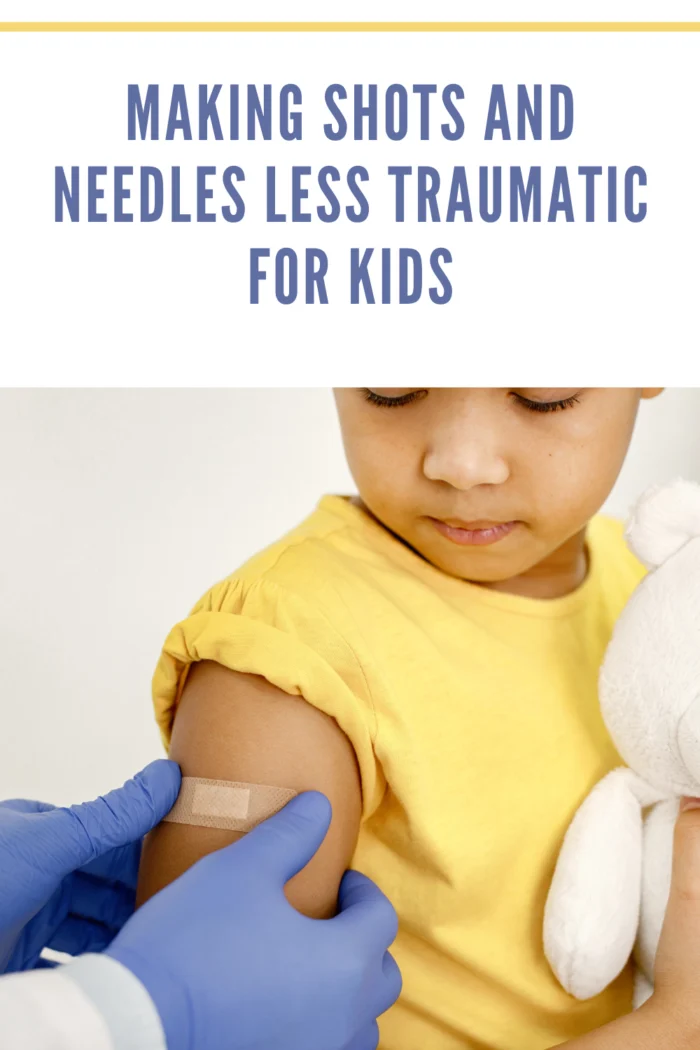5 Tips for Making Shots and Needles Less Traumatic for Kids: A Guide for Anxious Parents
No parent eagerly anticipates taking their infants, toddlers, or even older children in for their dreaded shots and vaccinations (CDC). The heart-wrenching scene of teary-eyed or screaming kids, coupled with the anxiety that engulfs parents, can make these moments truly daunting. However, it’s important to acknowledge that vaccinations are an indispensable aspect of safeguarding your children’s health and preventing diseases.
But here’s the good news—it doesn’t have to be a nightmarish experience that leaves the whole family feeling emotionally drained. In fact, the process can be made much smoother with just a few tips and tricks up your sleeve. By implementing these strategies, you can effectively reduce tension and minimize tears, making the entire experience less traumatic for everyone involved.

-
- Preparation and Communication: One of the most effective ways to ease the stress of vaccinations is through preparation and open communication with your child. Talk to them about the upcoming visit to the doctor’s office, emphasizing the importance of staying healthy and strong. Use simple and age-appropriate language to explain what a vaccination is and how it helps protect them from illnesses. Encourage your child to express their feelings and concerns and validate their emotions. This approach will create a sense of understanding and trust, making them feel more at ease during the process.
- Distraction Techniques: Distraction can be a powerful tool in reducing anxiety. Bring along your child’s favorite toy or book to the appointment. Engage them in fun games or storytelling while waiting for their turn. Some healthcare facilities even offer child-friendly distractions, such as colorful wall art or interactive displays, to keep young minds occupied during the brief procedure. These distractions can divert their attention away from the needle and minimize their discomfort.
- Positive Reinforcement: Offering positive reinforcement can be immensely beneficial in encouraging your child to handle vaccinations more bravely. Praise and reward them for their courage and cooperation during the appointment. This could be as simple as a hug, a high-five, or a small treat afterwards. Positive associations with the experience can help lessen their apprehension about future visits.
- Be Calm and Supportive: Children are often keen observers of their parents’ emotions. If you display anxiety or fear, your child is likely to mirror those emotions. As a parent, try to remain calm and composed during the vaccination process. Hold your child’s hand, provide comforting words, and offer a sense of security. Your steady presence can instill confidence in your child, helping them feel more secure and less distressed.
- Turn It Into a Learning Opportunity: Use the vaccination visit as an opportunity to educate your child about the wonders of science and the importance of vaccinations in protecting their health and the health of others. You can find age-appropriate books or videos that explain the immune system and how vaccines work in simple terms. This can empower your child with knowledge and contribute to their understanding of why vaccinations are crucial.

Additional Tips to Ease the Vaccination Experience:
- Breastfeeding: For infants and toddlers, breastfeeding can offer a valuable source of comfort and reassurance during vaccination. If possible, time your appointment so that you can breastfeed your child while the doctor administers the shot. Alternatively, consider using a bottle with a “sweet-ease” (sugar-water) solution, which has been shown to reduce negative reactions to shots, especially when combined with other tactics.
- Comfort: To help keep your child calm, hold them in your arms during the vaccination process. Being close to you provides a sense of security and can make the experience less distressing for your little one. Most doctors are accommodating of this approach, as it helps keep children at ease.
- Combination Shots: Inquire about combination vaccinations that bundle multiple vaccines into a single shot. These combinations not only offer added value for each visit but also mean fewer shots for your child, reducing overall stress.
- Acetaminophen: If the pain from shots is a concern, consult your doctor about giving your child a child-sized dose of acetaminophen before the appointment. However, make sure to seek medical advice to ensure this is safe for your child.
- Topical Anesthetics: Consider discussing the use of topical anesthetics with your doctor, such as lidocaine-based creams like EMLA or LMX. These creams can numb the skin and help reduce the pain and trauma associated with shots. Note that a prescription may be required for these anesthetics.
Remember, making shots and needles less traumatic for kids requires patience, empathy, and creativity. Each child is unique, so experiment with different techniques to discover what works best for your little one. By proactively implementing these strategies, you can turn what once was a daunting experience into a manageable and even positive one for both you and your child.
